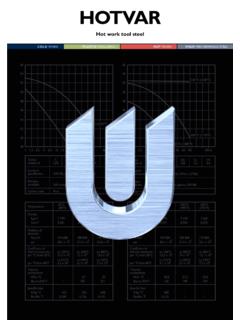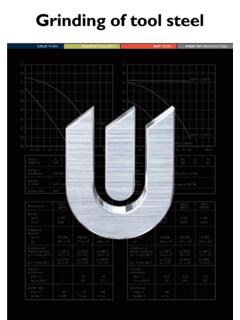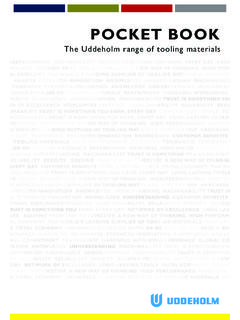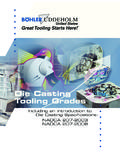Transcription of Welding of tool steel - Bohler Uddeholm
1 Welding of tool steel1 Welding of tool steelWelding of tool steel2 ContentIntroduction .. 3 General information onwelding of tool steel .. 3 Welding methods for tool steel .. 4 The Welding bay .. 5 Filler-metal characteristics .. 6Be careful as regards hydrogen! .. 8 Elevated working temperature .. 10 Welding procedure .. 11 Weld repair of hot work tool steel .. 13 plastic mould steel .. 14 cold work tool steel .. 15 This information is based on present state of knowledge and isintended to provide general notes on our products and theiruses.
2 It should not therefore be construed as a warranty ofspecific properties of the products described or a warranty forfitness for a particular of tool steel3 IntroductionThe weldability of steels with more than0,2% carbon is usually considered to bepoor. Hence, tool steels with 0,3 2,5%carbon are difficult to weld and manysteel suppliers will actually recommendagainst Welding . However, improvedquality of consumables, refined weldingequipment, developments in weldingtechnique and, not least, improvementsin tool steel quality have combined torender tool Welding as a realistic possi-bility, which can have considerableeconomic , Uddeholm recognizes thattool steels often need to be welded.
3 Thisis especially true for expensive toolinglike die-casting dies, large forging dies,plastic moulds, carbody dies and blank-ing tools where repair and adjustmentvia Welding is highly cost-attractive incomparison with the expense of produc-ing new informa-tion on Welding oftool steelTool steels contain 0,3 2,5% carbon aswell as alloying elements such asmanganese, chromium, molybdenum,tungsten, vanadium and nickel. Themain problem in Welding tool steelstems from its high hardenability. Weldscool quickly once the heat source isremoved and the weld metal and partof the heat-affected zone will transformation generates stressesbecause the weld is normally highlyconstrained, with a concomitant risk forcracking unless great care is what follows, a description isgiven of the Welding equipment, weld-ing technique and weld consumablesthat are required in order to weld toolsteel successfully.
4 Of course, the skilland experience of the welder is also aThe Welding ingredient in obtaining satisfactoryresults. With sufficient care, it is possibleto achieve weld repairs or adjustmentswhich, in terms of tooling performance,are hardly inferior to that of the of tooling may be requiredfor anyone of the following reasons: Refurbishment and repair of crackedor worn tooling Renovation of chipped or worncutting edges, on blanking tools Adjustment of machining errors intool making Design of tool steel4 Welding methodsfor tool steelSHIELDED METAL-ARC Welding (SMAW OR MMA)PrincipleAn electric arc generated by a DC or ACpower source is struck between acoated, rod-like electrode and the work-piece (Fig.)
5 1).The electrodes consist of a centralwire core, which is usually low-carbonsteel, covered with a coating of pressedpowder (flux). The constitution of thiscoating is complex and consists of ironpowder, powdered ferro-alloys, slagformers and a suitable binder. The elec-trode is consumed under the action ofthe arc during Welding and drops ofmolten metal are transferred to theworkpiece. Contamination by air duringthe transfer of molten drops from elec-trode to workpiece and during solidifi-cation and cooling of the weld depositis inhibited partly by slag formed fromconstituents in the electrode coatingand partly by gases created duringmelting of the composition of the depositedweld metal is controlled via the consti-tution of the electrode TUNGSTEN-ARC Welding (GTAW OR TIG)
6 PrincipleIn MMA Welding , the electrode rod fromwhich the arc is struck is consumedduring electrode in TIG Welding is madeof tungsten or tungsten alloy which hasa very high melting point (about3300 C/6000 F) and is therefore notconsumed during the process (Fig. 2).The arc is initially struck by subjectingthe electrode-workpiece gas to a high-frequency voltage. The resulting ioniza-tion permits striking without the neces-sity for contact between electrode andworkpiece. The tungsten electrode isalways connected to the negative ter-minal of a DC power source becausethis minimizes heat generation andthereby any risk of melting the elec-trode.
7 Current is conducted to the elec-trode via a contact inside the consumables which are requiredduring TIG- Welding are fed obliquelyinto the arc in the form of rod or of the weld pool is preventedby an inert-gas shroud which streamsfrom the TIG tun over the electrode sourceTIG Welding can be performed with aregular MMA power source providedthis is complemented with a TIG controlunit. The gun should be water cooledand be capable of handling a minimumcurrent of 250 A at 100% gas lens is also a desirable feature inorder that the inert gas protection is asefficient as possible.
8 Welding is facili-tated if the current can be increasedsteplessly from zero to the sourceFor MMA Welding , it is possible to useeither an AC or DC power , whichever is used, the sourcemust provide a voltage and currentwhich is compatible with the arc voltages are: Normal recovery electrodes: 20 30 V High recovery electrodes: 30 50 VUddeholm Welding consumables areof normal-recovery type. A suitablepower source for these is a DC unit withan open voltage of 70 V and which iscapable of delivering 250A/30 V at 35% Metal-arc Welding (MMA) Welding rectifierElectrodeElectrode holderPower source +Pole PoleFig.
9 1 WeldFiller rod + Pole gasShielding gasFig. 2 WorkpieceWorkpiece Weld Slag Molten poolWelding torchTungstenelectrodePower supplyCooling waterWelding of tool steel5 PREHEATING EQUIPMENTTool steels cannot be welded at roomtemperature without considerable riskfor cracking and it is generally neces-sary to pre-heat the mould or die beforeany Welding can be attempted (seelater). While it is certainly possible toweld tools successfully by preheating ina furnace, the chances are that thetemperature will fall excessively prior tocompletion of the work.
10 Hence, it isrecommended that the tool be main-tained at the correct temperature usingan electrical heating box supplied froma current-regulated DC source. Thisequipment also enables the tool to beheated at a uniform and controlled minor repairs and adjustments, itis acceptable that the tool be preheatedusing a propane torch. Hence, liquidpropane cylinders should be available inthe Welding elements foran insulated preheating MACHINESThe following should be available: Disc grinder with minimum 180 x6 mm wheel (7 x 0,25 inch) forpreparing the joint and grinding outof any defects which may occurduring Welding .









